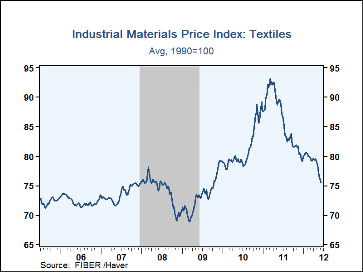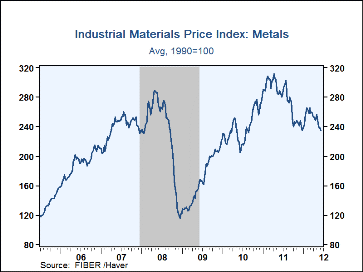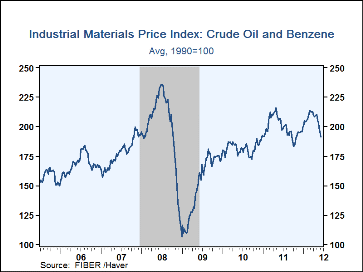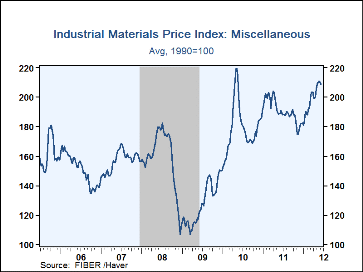 Global| Jun 11 2012
Global| Jun 11 2012FIBER: Industrial Commodity Price Declines Are Broad-Based
by:Tom Moeller
|in:Economy in Brief
Summary
A loss of forward economic momentum in industrial countries, worldwide, has prompted notable commodity price declines across categories. At 163.7, the latest price index from the Foundation for International Business and Economic [...]
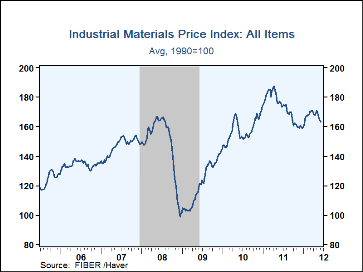 A loss of forward economic momentum in
industrial countries, worldwide, has prompted notable commodity price
declines across categories. At 163.7, the
latest price index from the Foundation for International Business and
Economic Research (FIBER) was down 4.3% from its April high and off 7.2%
from one year ago. During the last ten years there has been a 44%
correlation between the three-month change in prices and the change in
factory sector industrial production.
A loss of forward economic momentum in
industrial countries, worldwide, has prompted notable commodity price
declines across categories. At 163.7, the
latest price index from the Foundation for International Business and
Economic Research (FIBER) was down 4.3% from its April high and off 7.2%
from one year ago. During the last ten years there has been a 44%
correlation between the three-month change in prices and the change in
factory sector industrial production.
In the metals group, prices have fallen 17.2% y/y led lower by aluminum prices which are off one quarter y/y and by nearly one-third from the 2011 peak. Declines of copper scrap also have been sizable though steel scrap prices have remained relatively firm. Textile prices also have fallen sharply (-14.1% y/y) led by declines in cotton prices, which are down by one-half y/y and by two-thirds from the 2011 peak.
Lower crude oil prices, down 16.8% y/y, have added to the weakness in the overall pricing environment. Prices for the petro-chemical benzene have shown lesser declines. Only in the miscellaneous group have prices shown relative strength.
Overall, this index has risen 10.5% y/y led by higher lumber & plywood prices, which have been bolstered by strong world-wide demand and limited supplies. Elsewhere, natural rubber pries have weakened with lessened strength in global motor vehicle sales.Relating Commodity Prices to Underlying Inflation: The Role of Expectations from the Federal Reserve Bank of Dallas is available here.
Commodity price data can be found in Haver's DAILY, WEEKLY, USECON and CMDTY databases.
| FIBER Industrial Materials Price Index (1990=100) | 06/08/12 | Y/Y % | 2011 | 2010 | 2009 |
|---|---|---|---|---|---|
| All Items | 163.7 | -7.2 | 172.9 | 157.7 | 121.4 |
| Textiles | 76.4 | -14.1 | 86.1 | 81.2 | 73.3 |
| Cotton (cents per pound) | 67.6 | -55.1 | 132.6 | 87.8 | 52.2 |
| Metals | 237.0 | -17.2 | 278.5 | 239.9 | 167.9 |
| Aluminum ($ per metric ton) | 1,946.5 | -25.8 | 2,400 | 2,172 | 1,662 |
| Copper Scrap (cents per pound) | 339.6 | -16.4 | 400.1 | 326.5 | 195.2 |
| Steel Scrap ($ per ton) | 399.0 | -1.1 | 412.4 | 325.7 | 203.4 |
| Crude Oil & Benzene | 191.8 | -7.8 | 199.3 | 182.0 | 150.9 |
| Crude Oil (WTI, $ per Barrel) | 84.8 | -16.8 | 95.1 | 79.5 | 61.4 |
| Miscellaneous | 208.3 | 10.5 | 190.5 | 178.8 | 127.6 |
| Framing Lumber ($ per 1000 board ft.) | 343 | 31.4 | 273 | 282 | 221 |
| Natural Rubber (cents per pound) | 242.4 | -8.1 | 261.8 | 181.8 | 83.0 |
Tom Moeller
AuthorMore in Author Profile »Prior to joining Haver Analytics in 2000, Mr. Moeller worked as the Economist at Chancellor Capital Management from 1985 to 1999. There, he developed comprehensive economic forecasts and interpreted economic data for equity and fixed income portfolio managers. Also at Chancellor, Mr. Moeller worked as an equity analyst and was responsible for researching and rating companies in the economically sensitive automobile and housing industries for investment in Chancellor’s equity portfolio. Prior to joining Chancellor, Mr. Moeller was an Economist at Citibank from 1979 to 1984. He also analyzed pricing behavior in the metals industry for the Council on Wage and Price Stability in Washington, D.C. In 1999, Mr. Moeller received the award for most accurate forecast from the Forecasters' Club of New York. From 1990 to 1992 he was President of the New York Association for Business Economists. Mr. Moeller earned an M.B.A. in Finance from Fordham University, where he graduated in 1987. He holds a Bachelor of Arts in Economics from George Washington University.


